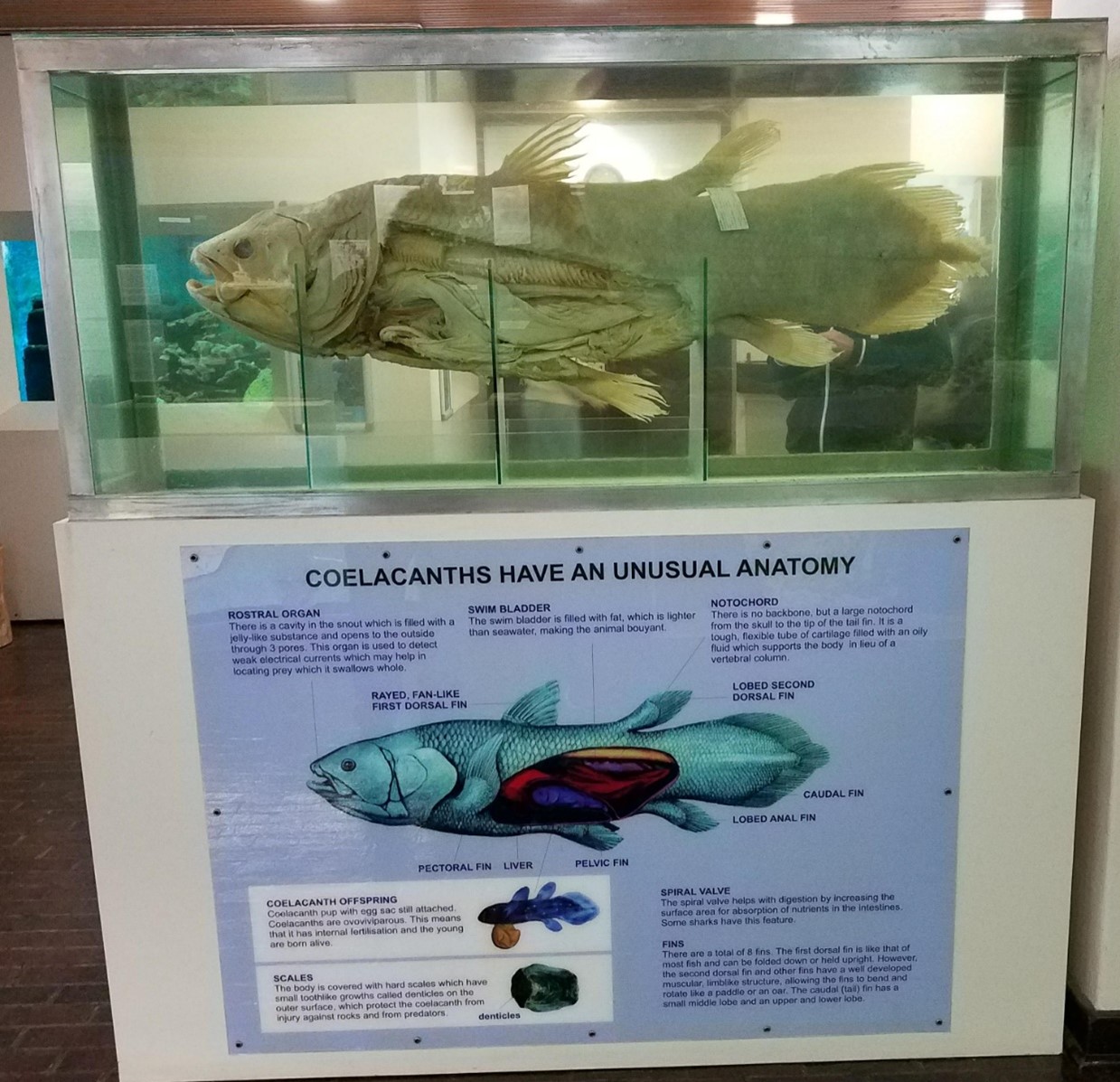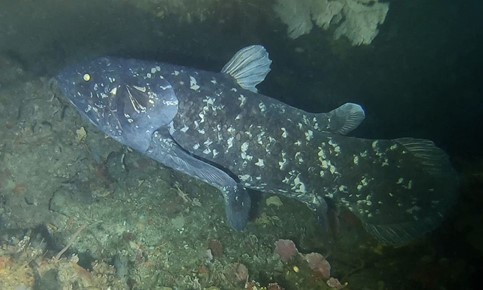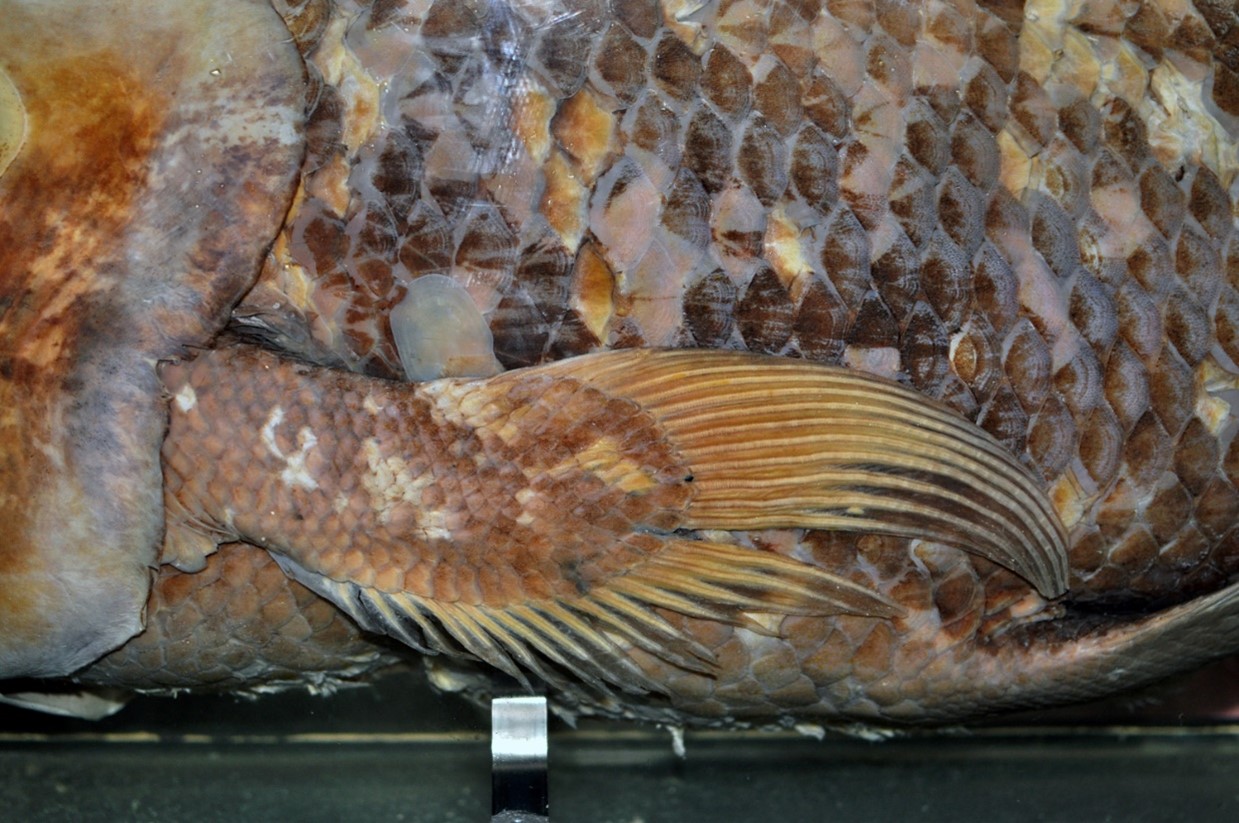| (Copyright) by Jerry Bergman (Powder Springs, Georgia) |
|---|
| For close to a century, evolutionists taught that certain traits of coelacanths (figs. 1 and 2), then known only as fossils (fig. 3), meant they were the precursors of four-limbed animals (tetrapods) that walked on land. For example, coelacanths had lobed fins (fig. 4) instead of rayed fins (fig. 5), a trait shared only with lungfish. The lobed fins had a round fleshy base, resembling short stubby legs, with other smaller fins seemingly taking the place of feet. Louis Agassiz first described the coelacanth group in 1839, and paleontologists have found dozens of fossil coelacanth species since then. But none have ever been found in rocks deemed younger than the Cretaceous, which supposedly ended 66 million years ago (mya). So, they were firmly regarded as extinct. Found alive Wikimedia Commons  Figure 1. Preserved modern coelacanth with some of its anatomy on display in Makhanda, South Africa. Wikimedia Commons  Figure 2. Live coelacanth off the South African coast in 2019. In 1938, the discovery of a live coelacanth near Madagascar astounded evolutionists. It was like finding a live dinosaur! Once the discovery was confirmed, newspaper headlines all over the world proclaimed the amazing news. The shock was not only because these fish had disappeared from the fossil record allegedly vast ages ago, only now to be discovered alive, but also because it supposedly provided “a glimpse of the fish that first walked on land”.1 The coelacanth “was generally thought to be the ‘missing link’ between aquatic and terrestrial vertebrates”.2 This was critical to evolutionists because the vertebrate sea-to-land transition is one of the most important steps in their story. The coelacanth was already badly deteriorated before being mounted by a local taxidermist. Nonetheless, when finally subjected to expert examination by South African ichthyologist J.L.B. Smith, he confirmed it to be a coelacanth, and published his findings in Nature.3 Smith became obsessed with finding another one, but an extensive years-long search, not helped by the intervention of WWII, failed. Following the war’s end in 1945, Smith distributed thousands of leaflets in three languages with pictures of the fish. These offered £1,000 sterling (c. US$60,000 today) for information leading to new specimens.4 After seven years, in December 1952, one was caught near the Comoro Islands, off the south-eastern coast of Africa. It now had to be preserved and transported to Smith’s lab hundreds of kilometers away before it rotted like the first one had. The French Prime Minister, an admirer of Smith’s book about African fishes, arranged for Smith to fly to the Comoro Islands carrying formalin preservative. Coelacanths have unique traits that make it difficult for evolutionists to claim what creature they evolved from, and what creature they might have evolved into. When he saw the fish, Smith was ecstatic; his 14-year search had finally paid off! Now the evolution of limbs could be proven. His success made headlines around the world. By 1975, hundreds more live specimens had been caught, 85 of them described in the scientific literature. Coelacanths have now been found off the coasts of the Comoros, Kenya, South Africa, Tanzania, Mozambique, Madagascar, and Indonesia. The ones found off Indonesia in the late 1990s have been deemed a separate species. Extant coelacanths are estimated to live as long as 60 years. They can grow to 2 m (6.5 ft) in length and weigh around 90 kg (200 lb). Unique traits Wikimedia Commons  Figure 3. Coelacanth fossil from Jurassic limestone, c. 150m years ‘old’. Arrow shows epicaudal fin. Wikimedia Commons  Figure 4. The pectoral ‘lobed’ fin of a Coelacanth (Latimeria chalumnae) from the Muséum national d’histoire naturelle (Paris, France). The lobe contains muscle and bone. Coelacanths have unique traits that make it difficult for evolutionists to claim what creature they evolved from, and what creature they might have evolved into. For example, most fish have smooth scales; however, coelacanth scales are smooth on the lower half of their bodies, and rough on the upper half. The steel-blue colour of their scales is also unique. They have eight fins—two dorsal, two pectoral, two pelvic, one anal, and one caudal (tail) fin. The superficial resemblance of four of their fins to stumpy legs excited evolutionists into speculating they were forerunners to actual legs. The intense desire to find a ‘missing link’ likely made it difficult for researchers to consider alternative reasons why the fish had this design, except perhaps to ‘walk’ on the ocean floor. This is what Smith believed they did—until detailed observations of the living fish in its natural environment showed otherwise. The ability of its muscular fins to rotate 180 degrees gives the fish outstanding underwater manoeuvring and hovering ability. The caudal (tail) fin has an ‘extension’ called an epicaudal fin [arrow fig. 3], unique to coelacanths. It moves independently and is thought to have sensory as well as locomotory function.5 The coelacanth’s eyes are very large, while its mouth, though comparatively small, can open very wide. Coelacanth skulls are completely split in half by an ‘intracranial joint’—a feature not found in any other living vertebrate—which greatly increases the mouth gape. Its main function was thought to be to allow sufficiently rapid mouth opening to create suction, pulling prey inwards. Recent modelling, however, has emphasized its role in increasing bite strength.6 Wikimedia Commons  Figure 5. A typical ‘rayed’ fin by comparison, on the side of a Symphysodon aequifasciatus at Germany’s Karlsruhe Zoo. Instead of a backbone, these vertebrates have a hollow cartilage structure called a notochord that is filled with oil. (‘Coelacanth’ means ‘hollow spine’, though the name is derived from its hollow fin spines.) In adult coelacanths, the brain, much of it dedicated to vision, occupies only 1.5% of the braincase; the rest is filled with fats and oils. But in young fish, the brain fills it entirely.7 Unique among living animals, coelacanths have a large central jelly-filled cavity in their snout, called the rostral organ. Experiments suggest it is used to detect weak electrical impulses given off by prey. The coelacanth’s large eyes contain an unusually high number of rods, and a tapetum (reflective tissue behind the retina) like a cat’s, providing excellent vision in its dark undersea world.8 Its swim bladder, instead of being filled with gas as in most other fish, is filled with fat, allowing it to hover effortlessly at a consistent depth underwater. It has acute hearing, achieved by a basilar papilla (sensory organ), similar to that of land-dwelling tetrapods but no other fish, including the lungfish.9 It is clearly well-designed as a deep-water fish. In fact, coelacanths cannot survive long outside this very specific niche. Comoran fishermen caught 150 between 1952 and 1987. They attempted to save them, even placing them in aquarium tanks, but all died within a few hours. The controversy Evolutionary paleontologists hypothesized that the missing link between fish and walking land animals was a lobe-finned fish that lived a supposed 300 mya. Their two chief candidates were the lungfish and the coelacanth, and scientists argued for decades over which of these might have been the ancestor of tetrapods. When the live coelacanth was discovered in 1938, some seized on the dramatic idea that the coelacanth was the missing link. However, despite Smith’s decades of effort, this notion is no longer widely held. A related group, the lungfishes, which also exist today, are considered by many evolutionists to be such a link. However, many problems exist for all proposed evolutionary links from fish to land animal, including the famous Tiktaalik.10 No evidence exists for coelacanth evolution. No coelacanth evolution No evidence exists for coelacanth evolution. Although dozens of coelacanth fossils have been found, as far as can be determined they are all anatomically near-identical to living examples. In the long-age geological system, they are supposed to have first lived c. 400 mya, over 100 million years before dinosaurs are said to have appeared. Judging by detailed external features, “it is difficult to separate the new living fish from some of the old genera which are represented by fossils.”11 Except for differences in size, coelacanths have, according to the evolutionary time scale, not changed in some 400 million years. Because of their reappearance alive after supposedly disappearing from the fossil record c. 70 mya (in evolutionary time) they are known as a ‘Lazarus taxon’. Such instances speak against the long-age timescale; for coelacanths, one would have to believe they lived through some 70 million years, yet not one of their fossils has ever been found within the layers supposedly representing that entire period! Summary and conclusion An enormous amount of research has been done on the coelacanth. Dozens of scientists have written scores of articles trying to demonstrate that it is a ‘missing link’ between fish and land animals. The coelacanth story has been long and extensive, but in the end has supported the conclusions of creationists—coelacanths may have varied a little but have always been coelacanths. References and notes 1. Amemiya, C. et al., The African coelacanth genome provides insights into tetrapod evolution, Nature 496:311–316, 2013. Return to text. 2. Meyer, A., Molecular evidence on the origin of tetrapods and the relationships of the coelacanth, Trends in Ecology & Evolution 10(3):111–116, 1995. Return to text. 3. Smith, J.L.B., A Living Fish of Mesozoic Type, Nature 143(3620):455-456, 1939. Return to text. 4. Weinberg, S. A Fish Caught in Time: The Search for the Coelacanth. New York, NY: HarperCollins, p. 50, 2000. Return to text. 5. Hissman, K. and Fricke, H., Movements of the epicaudal fin in coelacanths, Copeia 1996(3):606–615, 1996. Return to text. 6. Dutel, H., and 3 others, Bite force in the extant coelacanth Latimeria: the role of the intracranial joint and the basicranial muscle, Current Biology 25(9):1228–1233, 2015. Return to text. 7. Thomson, Keith S., Living Fossil: The Story of the Coelacanth, W.W. Norton, New York, pp. 172–173, 1991. Return to text. 8. Thomson, K, ref. 7, p. 173. Return to text. 9. Fritzsch, B., Inner ear of the coelacanth fish Latimeria has tetrapod affinities, Nature 327(6118): 153–154, 1987. Return to text. 10. Walker, T., Is the famous fish-fossil finished? Tiktaalik, the transitional star, faces an evolutionary dead-end, Creation 32(3):38–39, 2010. Also Curtis, J., What’s so great about Tiktaalik? J. Creation, 34(1)110–114, 2020. Return to text. 11. Woodward, A.S., The surviving crosso-pterygian fish, Latimeria, Nature 146(3689):53–54, 1940. Return to text. ——————————————————————————————— Reprinted with permission from: Creation Ministries International https://creation.com/ ——————————————————————————————— |
Views: 18
Sign up to Receive [The "New" Church of God Messenger] weekly newsletter: